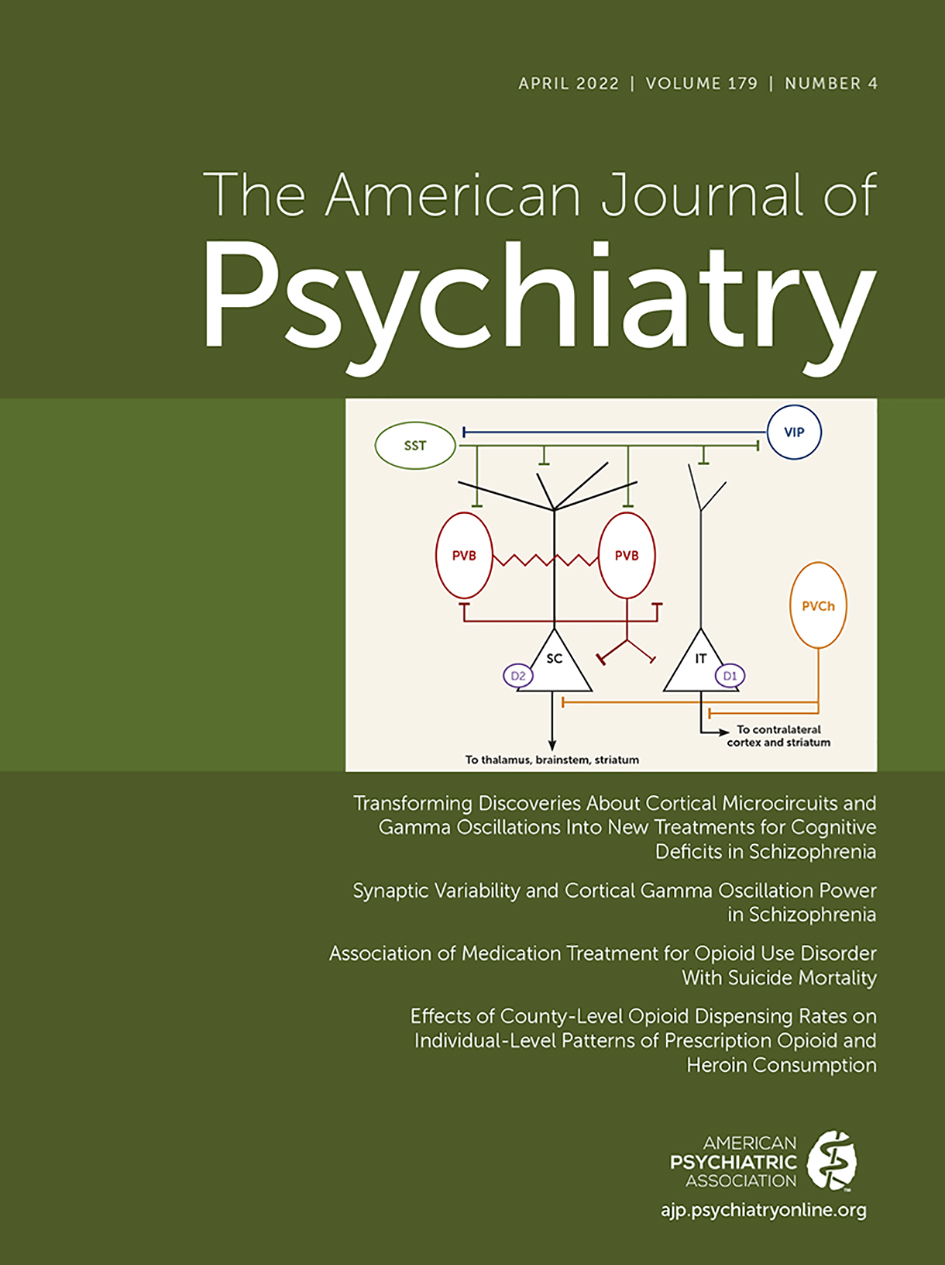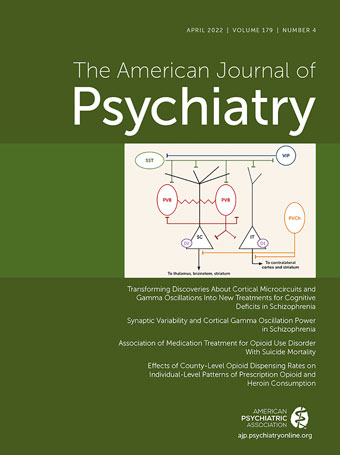The United States has seen an unprecedented rise in drug overdose deaths and suicides in the past two decades that has garnered increased public health attention since the COVID-19 pandemic, which caused social and economic disruption and had considerable impacts on nationwide mental health. Despite a recent decline in overall rates since 2019, suicide has remained a leading cause of death, with numbers continuing to rise in certain populations (
1). The suicide crisis has intersected with an epidemic of drug overdose deaths, which surpassed an annual rate of 100,000 for the first time in the 12 months ending in April 2021; overdose deaths increased by almost 29% from the previous year, and over 75% of overdoses were associated with opioids, primarily potent synthetics, including fentanyl (
2).
Although the etiology of suicide is multifactorial, the link between substance use disorders and suicide risk has been well documented (
3,
4). Opioid use disorder confers particular risk even after controlling for co-occurring psychiatric diagnoses; categorization of opioid overdose deaths as unintentional versus attributable to suicide is marked by challenges, as intent is not always known or documented at the time of death (
5). The Department of Health and Human Services and the Office of the Surgeon General issued a call to action in 2021 to implement the National Strategy for Suicide Prevention, which urges a broad public health response that includes risk identification, evidence-based treatment access, and prevention efforts targeting suicide (
6).
In this issue of the
Journal, the study by Watts et al. (
7) offers insights about suicide among patients with opioid use disorder (OUD) and discusses suicide-related phenomena in patients on medications approved for OUD treatment: buprenorphine, methadone, and naltrexone. This retrospective cohort study included more than 61,000 Veterans Affairs (VA) patients with OUD from 2003 to 2017 and examined suicide mortality, external causes of mortality, and all-cause mortality in the sample in the 5 years following initiation of medications for opioid use disorder (MOUD). Approximately half of patients were treated with buprenorphine, 25% with methadone, and 25% with naltrexone. Notably, over 35% of the sample had at least three additional mental health conditions, and patients received MOUD for a mean of only 151.2 days (SD=133.0) during the first year of observation, highlighting known challenges with MOUD adherence and retention (
8).
Periods on MOUD were associated with a hazard ratio of 0.45 (95% CI=0.32, 0.63) for suicide mortality relative to time off treatment; there were similar reductions in risk for external causes of mortality (hazard ratio=0.35, 95% CI=0.31, 0.40) and for all-cause mortality (hazard ratio=0.34, 95% CI=0.31, 0.37). Unlike findings from a previous study documenting increased suicide risk during 2-week periods transitioning on or off MOUD (
9), this study did not find significant differences in suicide risk during MOUD starting or stopping periods, although MOUD stopping periods had relatively greater risk. After adjusting for demographic characteristics, mental and physical health diagnoses, and health care utilization, the only identified risk factors for suicide mortality in this population were White race (hazard ratio=4.16, 95% CI=2.63, 6.58) and the presence of three or more psychiatric conditions (hazard ratio=1.62, 95% CI=1.14, 2.30).
When comparing effects on mortality risk across the three MOUD types, only buprenorphine had a significant effect on reducing suicide mortality and external causes of mortality in models adjusted for demographic characteristics, comorbidities, and health care utilization. Methadone was associated with reduced suicide mortality risk in unadjusted models only. All three MOUD types were associated with a significant protective effect in all-cause mortality, although naltrexone had a lesser magnitude of effect than buprenorphine or methadone. Overall, MOUD was associated with a greater than 50% reduction in risk of suicide mortality during periods of stable treatment, with an even larger reduction in external and all-cause mortality. The effect of buprenorphine treatment stood out as superior and was associated with a 65% reduction in suicide mortality risk.
The Watts et al. study contributes important evidence supporting the use of MOUD, especially buprenorphine, to reduce suicide mortality risk. Limitations included a sample that was predominantly male, White, and older, and use of a restricted range of health care utilization measures. Additionally, the time span of the study, while lengthy, represents a past OUD landscape dominated by heroin and physician-prescribed opioids, preceding the proliferation of fentanyl and other synthetics and the approval of extended-release forms of buprenorphine. Nevertheless, unlike previous work that primarily focused on all-cause mortality associated with MOUD, this study evaluates suicide mortality risk across medication periods (e.g., transition on and off MOUD and “stable” periods on and off MOUD) and compares risk between specific medications.
It is not surprising that buprenorphine was associated with the greatest reduction in suicide mortality among the MOUD treatments. Mechanistically, buprenorphine is a partial agonist at the mu opioid receptor with strong affinity at the receptor, such that it prevents binding by full agonist opioids, and is a nociceptin receptor agonist (
10). Notably, at higher doses, buprenorphine provides a ceiling effect at the mu receptor, inhibiting respiratory depression and other opioid effects that could contribute to overdose mortality. Methadone is a full opioid receptor agonist with NMDA antagonist properties (
11), and naltrexone is an opioid receptor antagonist.
Although mu opioid receptor activation is associated with increased dopamine levels and feelings of pleasure and contentment, buprenorphine also has a unique property as a kappa receptor antagonist, which confers additional mood-elevating effects in disease states. Buprenorphine has been studied as an intervention for treatment-resistant depression and has been associated with rapid alleviation of depressive symptoms and reduction in suicidal thoughts and self-injurious behaviors (
12). Antidepressant effects of buprenorphine have been reported in individuals with and without OUD and chronic pain (
13). Chronic pain is a relatively common comorbidity with OUD and an independent risk factor for suicide attempt; pain is associated with negative affect states that may be ameliorated by buprenorphine’s kappa antagonism in addition to its direct analgesic effects. Taken together, studies support greater relative importance of kappa antagonism in the antidepressant and antisuicide properties of buprenorphine than its mu agonism; mu opioid receptor antagonists administered in combination with buprenorphine do not block its antidepressant effects, and manipulations of mu receptor activity have yielded inconsistent effects on depression (
13).
Ample evidence supports MOUD benefits, including opioid use reduction, treatment retention, and reduced risk of infectious disease transmission and overdose. The article by Watts et al. highlights another important positive outcome supporting use of MOUD, particularly buprenorphine, in reduction of suicide mortality risk. Given elevated rates of suicidal ideation and behaviors observed in individuals with substance use disorders and co-occurring psychiatric disorders that are also associated with suicide risk, more attention should be directed to developing and implementing interventions targeting suicide risk identification, prevention, and treatment in this population. A comprehensive approach would employ multilevel interventions to synergistically reduce the various suicide risks among individuals with OUD and improve retention on MOUD. Efforts to identify individuals at risk for suicide at various stages of treatment, improve access to life-saving treatment interventions for substance use disorders, and strengthen protective factors are important and timely.
While the Watts et al. article is a worthwhile contribution to the literature on suicide among individuals with OUD, additional work is needed to delineate prevailing issues in broader samples (i.e., extending beyond the VA system) and in more recent times, considering the impacts of the COVID-19 pandemic, which may persist as factors in overdose and suicide. Further research is needed to identify optimal and scalable suicide prevention and treatment interventions across multiple health care settings, including combinations of pharmacotherapy and behavioral treatments tailored to target OUD and co-occurring psychiatric disorders and chronic pain. Improved and more systematic suicide risk assessment and linkage to care are needed across the OUD treatment continuum, including after recovery from nonfatal overdose, when patients should be strategically reengaged in MOUD to reduce recurrent accidental overdose as well as deliberate overdose that may be attributable to suicidal intent.

